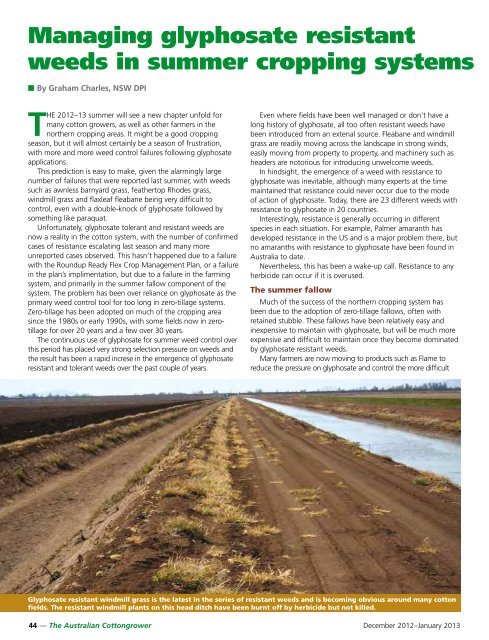cotton - Greenmount Press
cotton - Greenmount Press
cotton - Greenmount Press
You also want an ePaper? Increase the reach of your titles
YUMPU automatically turns print PDFs into web optimized ePapers that Google loves.
Managing glyphosate resistant<br />
weeds in summer cropping systems<br />
■ By Graham Charles, NSW DPI<br />
THE 2012–13 summer will see a new chapter unfold for<br />
many <strong>cotton</strong> growers, as well as other farmers in the<br />
northern cropping areas. It might be a good cropping<br />
season, but it will almost certainly be a season of frustration,<br />
with more and more weed control failures following glyphosate<br />
applications.<br />
This prediction is easy to make, given the alarmingly large<br />
number of failures that were reported last summer, with weeds<br />
such as awnless barnyard grass, feathertop Rhodes grass,<br />
windmill grass and flaxleaf fleabane being very difficult to<br />
control, even with a double-knock of glyphosate followed by<br />
something like paraquat.<br />
Unfortunately, glyphosate tolerant and resistant weeds are<br />
now a reality in the <strong>cotton</strong> system, with the number of confirmed<br />
cases of resistance escalating last season and many more<br />
unreported cases observed. This hasn’t happened due to a failure<br />
with the Roundup Ready Flex Crop Management Plan, or a failure<br />
in the plan’s implimentation, but due to a failure in the farming<br />
system, and primarily in the summer fallow component of the<br />
system. The problem has been over reliance on glyphosate as the<br />
primary weed control tool for too long in zero-tillage systems.<br />
zero-tillage has been adopted on much of the cropping area<br />
since the 1980s or early 1990s, with some fields now in zerotillage<br />
for over 20 years and a few over 30 years.<br />
The continuous use of glyphosate for summer weed control over<br />
this period has placed very strong selection pressure on weeds and<br />
the result has been a rapid increse in the emergence of glyphosate<br />
resistant and tolerant weeds over the past couple of years.<br />
Even where fields have been well managed or don’t have a<br />
long history of glyphosate, all too often resistant weeds have<br />
been introduced from an extenal source. Fleabane and windmill<br />
grass are readily moving across the landscape in strong winds,<br />
easily moving from property to property, and machinery such as<br />
headers are notorious for introducing unwelcome weeds.<br />
In hindsight, the emergence of a weed with resistance to<br />
glyphosate was inevitable, although many experts at the time<br />
maintained that resistance could never occur due to the mode<br />
of action of glyphosate. Today, there are 23 different weeds with<br />
resistance to glyphosate in 20 countries.<br />
Interestingly, resistance is generally occurring in different<br />
species in each situation. For example, Palmer amaranth has<br />
developed resistance in the US and is a major problem there, but<br />
no amaranths with resistance to glyphosate have been found in<br />
Australia to date.<br />
Nevertheless, this has been a wake-up call. Resistance to any<br />
herbicide can occur if it is overused.<br />
The summer fallow<br />
Much of the success of the northern cropping system has<br />
been due to the adoption of zero-tillage fallows, often with<br />
retained stubble. These fallows have been relatively easy and<br />
inexpensive to maintain with glyphosate, but will be much more<br />
expensive and difficult to maintain once they become dominated<br />
by glyphosate resistant weeds.<br />
Many farmers are now moving to products such as Flame to<br />
reduce the pressure on glyphosate and control the more difficult<br />
Glyphosate resistant windmill grass is the latest in the series of resistant weeds and is becoming obvious around many <strong>cotton</strong><br />
fields. The resistant windmill plants on this head ditch have been burnt - off by herbicide but not killed.<br />
44 — The Australian Cottongrower December 2012–January 2013

















